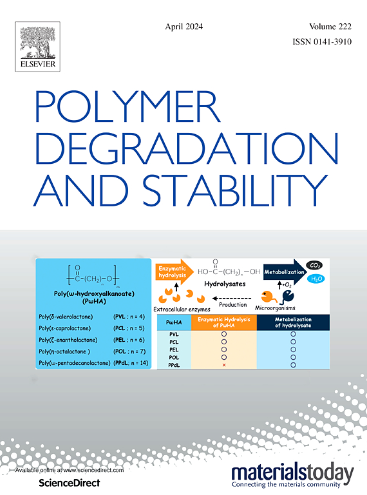Stacked graphene oxide and bio-sourced polyelectrolyte complexes thin coating for fire safe and sound absorbing flexible foams
IF 7.4
2区 化学
Q1 POLYMER SCIENCE
引用次数: 0
Abstract
Water based approaches aimed at the reduction of open cell foam flammability currently suffer from limited efficiency and practicability. In order to address this issue, this paper exploits the unique features of bio-sourced polyelectrolyte complexes (PECs) and high aspect ratio graphene oxide (GO), to deliver an efficient and high performing solution to foam flammability. To this aim, PECs encompassing gelatin and phytic acid were deposited on a brick-and-mortar graphene oxide polyacrylic acid (PAA) layer. This simple two-step deposition produces a stacked GO-PAA/PECs conformal coating on the 3D structure of the foam. The assembly produces a self-extinguishing behaviour during flammability tests in vertical configuration. The heat release rates are also reduced up to 50 % as assessed by forced combustion tests at 35 kW/m2. This set of FR properties has never been achieved before with such low number of deposition steps. In addition, the sound absorbing properties of the coated foams were evaluated by impedance tube tests, highlighting how these foams could find application as fire-safe sound-absorbing panel. The proposed approach thus represents an efficient step forward in the design of multifunctional fire-safe foams with potential industrial scalability.
叠层氧化石墨烯和生物源聚电解质复合物用于防火安全和吸声柔性泡沫的薄涂层
水基方法旨在降低开孔泡沫可燃性目前受到有限的效率和实用性。为了解决这一问题,本文利用生物源聚电解质复合物(PECs)和高纵横比氧化石墨烯(GO)的独特特性,提供了一种高效、高性能的泡沫可燃性解决方案。为此,将包含明胶和植酸的PECs沉积在砖和砂浆氧化石墨烯聚丙烯酸(PAA)层上。这种简单的两步沉积在泡沫的3D结构上产生堆叠的GO-PAA/PECs适形涂层。该组件在垂直配置的可燃性测试中产生自熄行为。通过35 kW/m2的强制燃烧测试,热释放率也降低了50%。这组FR性能以前从未实现过如此少的沉积步骤。此外,通过阻抗管试验对涂层泡沫的吸声性能进行了评价,强调了这些泡沫如何应用于防火吸声板。因此,所提出的方法代表了多功能防火泡沫设计的有效一步,具有潜在的工业可扩展性。
本文章由计算机程序翻译,如有差异,请以英文原文为准。
求助全文
约1分钟内获得全文
求助全文
来源期刊

Polymer Degradation and Stability
化学-高分子科学
CiteScore
10.10
自引率
10.20%
发文量
325
审稿时长
23 days
期刊介绍:
Polymer Degradation and Stability deals with the degradation reactions and their control which are a major preoccupation of practitioners of the many and diverse aspects of modern polymer technology.
Deteriorative reactions occur during processing, when polymers are subjected to heat, oxygen and mechanical stress, and during the useful life of the materials when oxygen and sunlight are the most important degradative agencies. In more specialised applications, degradation may be induced by high energy radiation, ozone, atmospheric pollutants, mechanical stress, biological action, hydrolysis and many other influences. The mechanisms of these reactions and stabilisation processes must be understood if the technology and application of polymers are to continue to advance. The reporting of investigations of this kind is therefore a major function of this journal.
However there are also new developments in polymer technology in which degradation processes find positive applications. For example, photodegradable plastics are now available, the recycling of polymeric products will become increasingly important, degradation and combustion studies are involved in the definition of the fire hazards which are associated with polymeric materials and the microelectronics industry is vitally dependent upon polymer degradation in the manufacture of its circuitry. Polymer properties may also be improved by processes like curing and grafting, the chemistry of which can be closely related to that which causes physical deterioration in other circumstances.
 求助内容:
求助内容: 应助结果提醒方式:
应助结果提醒方式:


